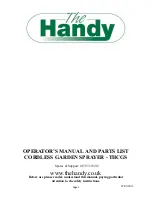
2
SAFETY PRECAUTIONS
This manual contains information that is important for you to know and understand.
This information relates to USER SAFETY and PREVENTING EQUIPMENT PROBLEMS.
Read and follow SAFETY PRECAUTIONS before using this equipment.
FIRE OR EXPLOSION HAZARD
1. When spraying, adequate exhaust must be provided to keep air free of accumulations of flammable vapors which may
cause fire or explosion.
2. Smoking must never be allowed in the spray area.
3. Static electricity is generated and a static spark could be produced in the spray area. To prevent the risk of fire or
explosion, ground all conductive objects in the spray area.
4. Make it sure to use and ground hoses with static wire for spray gun operation. If improperly grounded, a static spark
possibly produced may cause fire or explosion.
5. Fire extinguishing equipment must be provided in the spray area.
6. Solvents used for cleaning must have a flash point equal to or higher than that of the coating. Those for general
cleaning must have flash points above 37.8
℃
(100
°
F) to prevent the risk of fire.
INHALING TOXIC SUBSTANCES
1. Toxic vapors and liquids are harmful to health. When spraying, adequate exhaust must be provided to keep the air
free from accumulations of toxic materials and in the use at all times of respiratory protective equipment must be set
compulsory.
2. Always wear eye protection when spraying or cleaning the equipment.
3. Certain materials may be harmful if contacted with the skin. Read all labels and safety performance data of the
materials and solvents to be used. Appropriate clothes and gloves must be worn for spraying or cleaning the
equipment.
MISUSE
1. Operators should be given adequate and appropriate training in the safe use and maintenance of this equipment.
2. Pressured liquids may injure eyes. Do not point the spray gun to any person.
3. Gravity or suction feed gun must not be used for pressure feed gun.
4. Parts with compressed air may damage the human body. Connect air hoses tightly by using a spanner so that air
never leaks. If tightened loosely, hoses can be removed which may result in damaging the human body, objects to be
coated and other equipment used together.
5. Parts with compressed air or under spring pressure may injure the human body. When replacing such parts, clean the
spray gun by discharging the materials, discharge the air, remove air hose and fluid cup and then replace such parts by
placing the gun flat. Eye protection must be worn when repairing the spray gun.
6. Do not use the gun above maximum working pressure
(
0.69MPa
)
.
INSTALLATION
1. The air supplied to spray gun must be clean, in which any water, oil and solid material removed. It is recommended to
set up the Mist Separator and Air Transformer near the gun. The use of air not cleaned may cause coating troubles.
2. Connect fluid cup and air hoses tightly. If loose, hoses may disconnect, which may result in damaging the human body,
objects to be coated and other equipments used together.
3. Adjust Needle Packing (8) before use of a brand new gun. Tighten the Packing Gland (8) gradually and adjust the
needle to move smoothly. Untighten until the Needle (11) is not well pulled back.
OPERATION
1. The recommended pressure of air supplied to gun is in a range of 0.24MPa
~
0.30MPa for conventional type, and
0.19MPa
~
0.29MPa for LVMP type. Do not exceed the maximum working air pressure for proper usage (0.69MPa).
2. Try with the pressure starting from around 0.2MPa, as the spraying pressure varies depending upon the inner diameter
of gun, triggering distance, and materials etc.
3. The recommended spraying distance is 180mm. If the spray distance is too far, good result will not appear.
4. In order to get uniform finishing, the spray gun should be held vertically toward the painting surface.






















